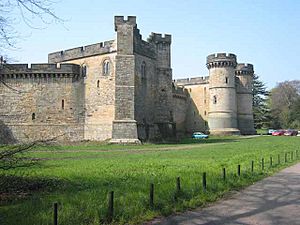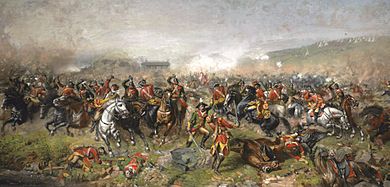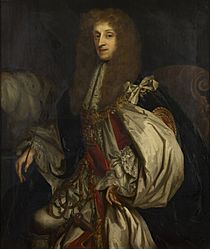Henry Belasyse (died 1717) facts for kids
Quick facts for kids
Sir Henry Belasyse
|
|
|---|---|

Brancepeth Castle, purchased by Belasyse in 1701
|
|
| Member of Parliament for Mitchell |
|
| In office November 1713 – January 1715 |
|
| Member of Parliament for City of Durham |
|
| In office November 1710 – February 1712 |
|
| Member of Parliament for City of Durham |
|
| In office December 1701 – 1708 |
|
| Member of Parliament for Morpeth |
|
| In office 1695 – November 1701 |
|
| Member of Parliament for Galway, Ireland |
|
| In office 1693–1695 |
|
| Personal details | |
| Born |
Henry Belasyse
1648 Biddick Hall, County Durham |
| Died | 14 December 1717 (aged 69) London |
| Resting place | Westminster Abbey |
| Nationality | English |
| Spouses | (1) Dorothy Benson 1680-1696 (2) Fleetwood Shuttleworth 1709 |
| Residence | Brancepeth Castle |
| Alma mater | Christ's College, Cambridge |
| Occupation | Soldier and politician |
| Military service | |
| Allegiance | |
| Years of service | 1674–1702 |
| Rank | Lieutenant-general |
| Unit | 6th Foot 1674–1688; 22nd Foot, 1689–1701; 2nd Foot 1701–1703 |
| Commands | Governor of Galway 1691–1692 Governor of Berwick 1713–1715 |
| Battles/wars | Franco-Dutch War Cassel; Saint-Denis Williamite War in Ireland The Boyne; Aughrim Nine Years' War Landen Namur 1695 War of the Spanish Succession Battle of Cádiz (1702) |
Sir Henry Belasyse (born 1648 – died 14 December 1717) was an English soldier and politician. He was also known as Bellasis. He came from County Durham and served as a MP for different areas between 1695 and 1715.
Henry Belasyse started his military career in 1674. He fought under William of Orange, who later became King of England. Belasyse was a skilled soldier and was given important commands. He helped William take control of northern England in 1688 during the Glorious Revolution. He then fought in wars in Ireland and Flanders (modern-day Belgium) until 1697.
In 1702, during the War of the Spanish Succession, he was involved in an event after the Battle of Cádiz. This event caused problems for the House of Habsburg, who were allies. Because of this, he was removed from the army in 1703. He never led troops in battle again. However, he was appointed Governor of Berwick-upon-Tweed from 1713 to 1715.
Belasyse first became an MP for Morpeth in 1693. He started as a Whig politician. Later, he was elected for Durham in 1701 with support from the Tory party. He served as an MP for Durham from 1701 to 1708, and again from 1710 to 1712. He then represented Mitchell, in Cornwall from 1713 to 1715. He did not run for election in 1715. Sir Henry Belasyse passed away in London on 14 December 1717 and was buried in Westminster Abbey.
Contents
Early Life and Family Background
Henry Belasyse was born in 1648 at Biddick House in County Durham. His father was Sir Richard Belasyse (1612–1651). His mother was Margaret (died after 1670). Henry had an older half-brother named William, who died in 1681, and a sister named Catherine.
The Belasyse family was large and well-known in Durham and Yorkshire. Henry's grandfather, Sir William, was a High Sheriff of Durham for many years. Unlike many of his relatives, Henry's father supported Parliament during the Wars of the Three Kingdoms. This meant his family's lands stayed mostly safe. Many other family members supported King Charles I of England.
In 1680, Henry Belasyse married Dorothy Benson (1636–1696). She was a widow with a son named Robert Benson. Henry and Dorothy had three children: Mary, Thomas, and Elizabeth. Sadly, all three children died before their father. In 1707, Henry married Fleetwood Shuttleworth (1676–1732). They had two children, Margaret and William (1697–1769). Margaret died when she was young.
Military Career and Key Battles
Henry Belasyse finished his studies at Christ's College, Cambridge, in 1667. He then spent some time at a law school called the Middle Temple. This was a common part of a gentleman's education back then.
In 1674, he joined the Scots Brigade. This was a group of soldiers who worked for the Dutch States Army. Belasyse's company joined one of the English regiments in this brigade. This regiment later became known as the 6th Foot.
He fought in the Franco-Dutch War. He was at the Battle of Cassel in 1677. Soon after, he became the Colonel of his regiment. He was injured at the Battle of Saint-Denis in 1678. This was the last battle of the Franco-Dutch War. He was made a knight sometime between 1678 and 1681.
In 1685, Belasyse went with the Brigade to England. They were sent by William of Orange to help King James II stop the Monmouth Rebellion. However, they returned without fighting. In 1688, King James wanted the whole Brigade to return to England. William refused but used this chance to remove officers he didn't trust.
Belasyse returned to England in April 1688. He became good friends with Lord Danby. Danby was a moderate Tory who invited William to become King of England. After William landed in England in November 1688, Belasyse joined Danby's forces. They took control of York, an important city, and then Hull, a major port.

In April 1689, Belasyse was promoted to brigadier general. In September, he became Colonel of a Regiment of Foot. This regiment fought in the Williamite War in Ireland from 1689 to 1691. He was at the Boyne, Aughrim, and the Siege of Limerick in 1691.
After Galway surrendered in July 1691, Belasyse was made its governor. He also received land in County Kerry. In 1692, he was elected as an MP for Galway Borough in the Irish Parliament. However, he was fighting in Flanders during this time.
In 1691, Belasyse was badly hurt in a duel in London. Duels were common, but Belasyse was not very popular. Even so, William continued to promote him. William often preferred Dutch or German officers over English ones.
After the war in Ireland, Henry went to Flanders to fight in the Nine Years War. He led a group of soldiers. At the Battle of Landen in 1693, he helped lead the defeated Allied soldiers to safety. In October 1694, he was promoted to lieutenant-general. His group helped protect the Allied forces during the 1695 siege of Namur. Belasyse helped cover the retreat of the Allied forces. In October 1695, he oversaw the trial of officers who had surrendered Diksmuide and Deinze.

The Treaty of Ryswick in 1697 ended the Nine Years' War. But it did not solve the question of who would become the next King of Spain. This issue had been important in Europe for over 30 years. Everyone knew that the peace would not last. The Tory party in Parliament wanted to cut military spending. By 1699, the English army had fewer than 7,000 men.
Just before the War of the Spanish Succession began in July 1701, Belasyse changed regiments. He became Colonel of the 2nd Foot. His old unit was sent to Jamaica, which was known for being unhealthy. In 1702, Belasyse was made second-in-command to the Duke of Ormonde. They led an Anglo-Dutch force to Spain to support Archduke Charles.
Belasyse and Major-General Charles O'Hara led the force that captured Port St Mary in 1702. After the town was captured, there were reports of soldiers taking things from the town and burning parts of it. Archduke Charles was upset by this and wanted the commanders punished. In December, Queen Anne ordered that any items taken from Port St Mary be returned. Belasyse was accused of being involved. He said he had parliamentary protection, but he was removed from the army. This ended his active military career.
Political Career and Later Life
In 1693, Belasyse bought the Owton estate in County Durham from his nephew. In 1695, he was elected as an MP for Morpeth. He usually voted with the Whigs. In 1701, he bought Brancepeth Castle. He was then elected for the nearby area of Durham in the November election, with support from the Tories.
He did not run in the 1708 election. However, he was elected again for Durham in 1710, when the Tories won many seats. He had to resign as an MP in 1712. This was because he accepted a job to look into military spending in Italy and Spain. When this job ended in 1713, he became an MP for Mitchell, in Cornwall. This was a "rotten borough," meaning it had very few voters.
He was also appointed Governor of Berwick-upon-Tweed. But like many Tories, he lost this job when George I became king in October 1714. He did not run in the 1715 election. Sir Henry Belasyse died in London in 1717 and was buried in Westminster Abbey.
Images for kids
-
Brancepeth Castle, purchased by Belasyse in 1701
Sources
| Military offices
|
||
|---|---|---|
| Preceded by Thomas Ashley |
Colonel of Belasyse's Regiment of Foot 1678–1689 |
Succeeded by William Babington |
| Preceded by The Duke of Norfolk |
Colonel of The Duke of Norfolk's Regiment of Foot 1689–1701 |
Succeeded by William Selwyn |
| Preceded by William Selwyn |
Colonel of the Queen Dowager's Regiment of Foot 1701–1703 |
Succeeded by The Earl of Portmore |
| Civic offices | ||
| Preceded by Arthur French |
Mayor of Galway 1691–1692 |
Succeeded by Thomas Revett |
| Parliament of Ireland | ||
| Preceded by Oliver Martin John Kirwan |
Member of Parliament for Galway 1692–1693 |
Succeeded by Richard St George Robert Ormsby |
| Parliament of England (to 1707) | ||
| Preceded by George Nicholas Roger Fenwick |
Member of Parliament for Morpeth 1695–1701 |
Succeeded by Emanuel Scrope Howe Sir John Delaval |
| Preceded by Charles Montagu Thomas Conyers |
Member of Parliament for Durham 1701–1707 |
Succeeded by Parliament of Great Britain |
| Parliament of Great Britain (1707–1800) | ||
| Preceded by Parliament of England |
Member of Parliament for Durham 1707–1708 |
Succeeded by Thomas Conyers James Nicolson |
| Preceded by Thomas Conyers James Nicolson |
Member of Parliament for Durham 1710–1712 |
Succeeded by Thomas Conyers Robert Shafto |
| Preceded by Abraham Blackmore Richard Belasyse |
Member of Parliament for Mitchell 1713–1715 |
Succeeded by Nathaniel Blakiston Robert Molesworth |



